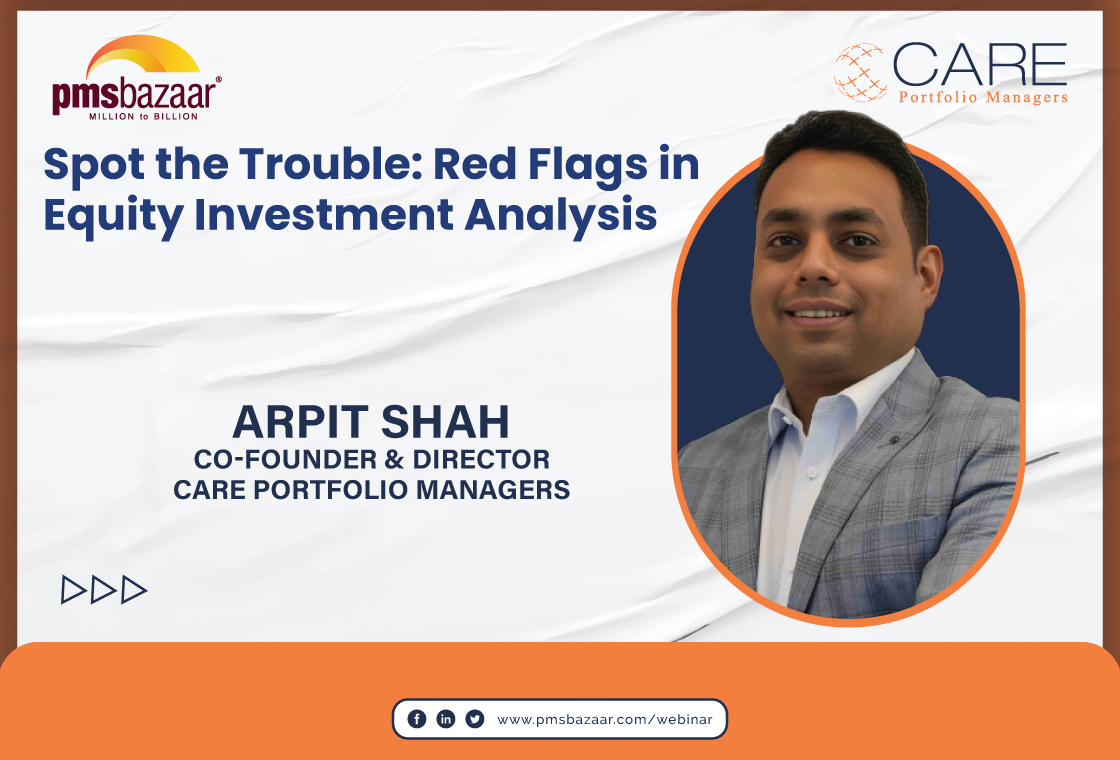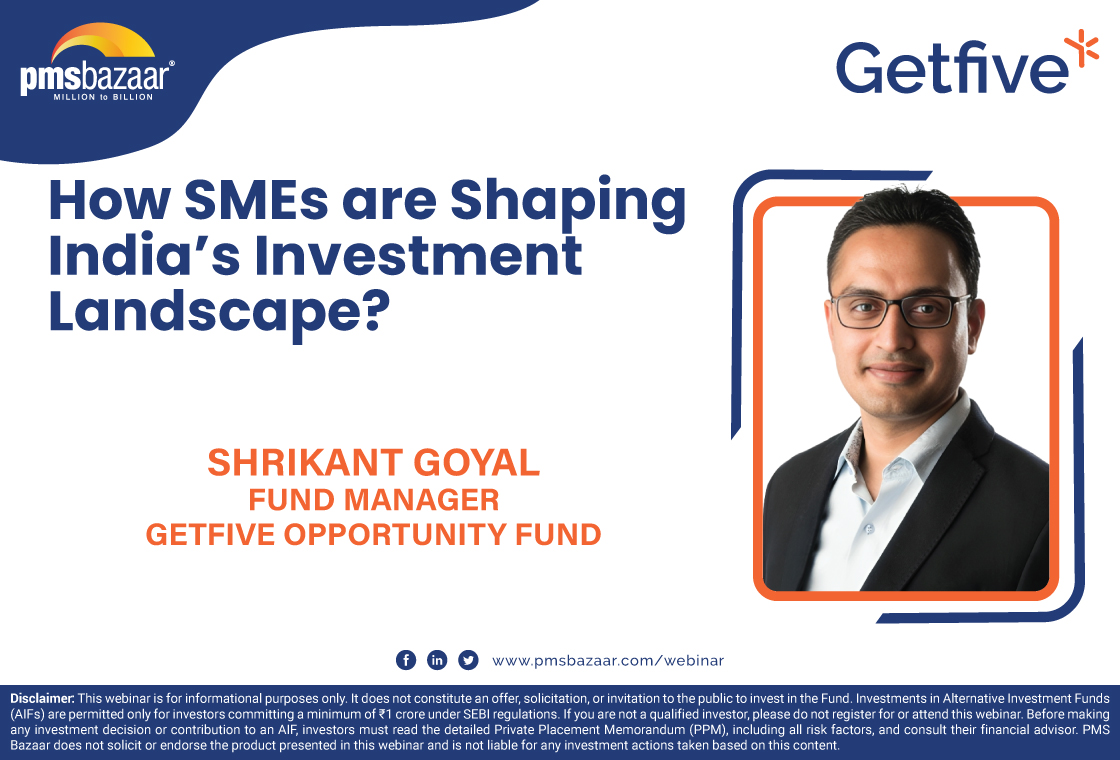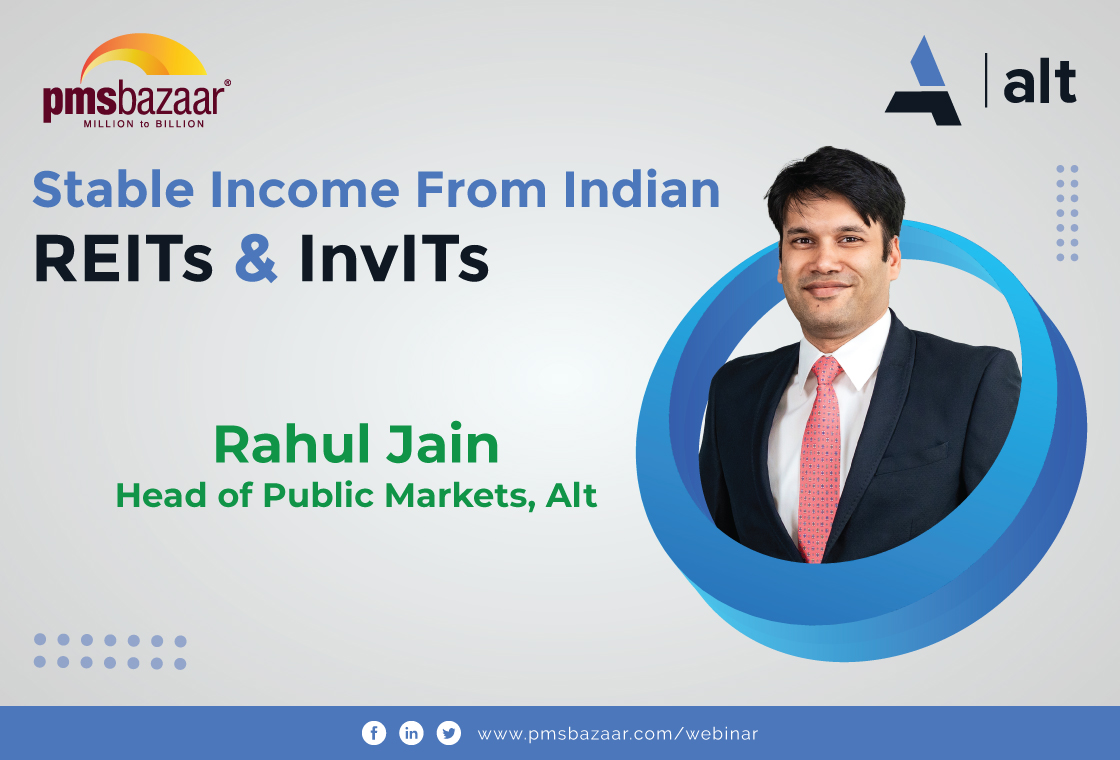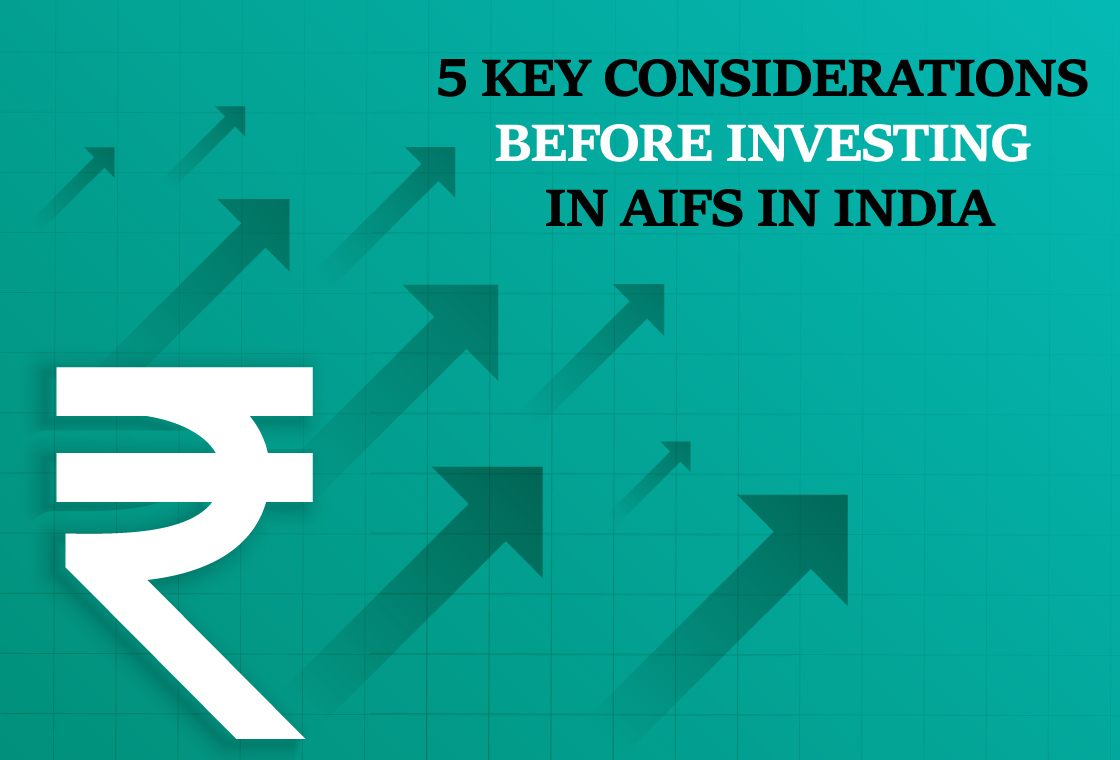PMS Bazaar recently organized a webinar titled “Mid & SmallCap Investing: Challenges, Alpha Potential & Winning Strategies,” which featured Mr. Sameer Narayan, Head – Alternate Investment Equity, Aditya Birla Capital.

This blog covers the important points shared in this insightful webinar.
The webinar blog covers insights from Mr. Narayan, which included expert insights on mid and small-cap investing. It explored challenges like identifying multibaggers, managing risks, understanding churn, and liquidity. It also covered growth versus value investing, realistic CAGR expectations, portfolio strategies, and high P/E stock analysis—highlighting the disciplined approach needed for long-term success in this volatile segment.
Key aspects covered in this webinar blog are
- The reality of multibagger potential
- Growth versus value in mid and small caps
- Managing risk in smaller companies
- The role of liquidity in returns
- Understanding churn rate
- Future growth expectations
- Drivers of portfolio growth
- Insights on high P/E companies and peer comparison
- Concluding remarks and future outlook
Summary: Mr. Sameer Narayan discussed the challenges of mid and small-cap investing, emphasising the rarity of finding multibaggers. He highlighted the need for sustainable growth, strong risk management, and liquidity as key indicators. He cautioned against high churn rates and unrealistic CAGR expectations. Citing historical data, he suggested a realistic CAGR of 12–15%, driven by consistent earnings and scalable businesses. He concluded with optimism about long-term returns, noting their portfolio's strong fundamentals and potential growth opportunities amid current market volatility.
Mr. Sameer Narayan started by addressing the challenges and nuances of investing in mid and small-cap companies. He began by stating that the primary reason for discussing this topic was the prevalence of misconceptions, particularly regarding investor expectations of finding the next multibagger.
The Reality of Multibagger Potential
Mr. Narayan pointed out that the historical data reveals a rather sobering truth: only a small fraction of listed companies successfully transition from small-cap to mid-cap and eventually to large-cap status. He cited an example of the BSE, where out of approximately 5,000 traded stocks, only about 25 to 30 companies, representing less than 0.5%, had made this entire journey over the past five years, a period considered favorable for market growth.
He elaborated that this transition requires a confluence of factors:
- Substantial business scale expansion.
- A sufficiently large market opportunity.
- The company's consistent execution.
The journey from the initial value discovery as a small-cap to the broader investor interest and increased trading volumes of a large-cap is a difficult one. Therefore, Mr. Narayan emphasized the need to have realistic expectations and to assess the historical probability of such transitions. He likened the search for the next multibagger to finding a needle in a haystack, underscoring that it is not a common occurrence.
Growth Versus Value in Mid and Small Caps
Mr. Narayan then shifted the discussion to the crucial aspect of growth versus value, particularly in the context of mid and small-cap investing. He stated that it is uncommon for a company initially valued as a value stock to evolve into a large-cap. Typically, mid and small-cap companies need to be growth-oriented, especially in a market like India.
He advised investors to consistently seek sustainable growth, which implies a significant and addressable market opportunity with a low probability of failure. He highlighted the "growth versus value paradox" in this segment, emphasizing that successful mid and small-cap investments are usually in companies with the potential to grow their addressable market size by a factor of three to four times to complete the journey from small to mid to large-cap.
Managing Risk in Smaller Companies
The third important aspect Mr. Narayan discussed was risk management. He stressed that managing risk is even more critical in the small and mid-cap space due to the higher mortality rate of these companies. Factors such as:
- Reliance on a single client or order.
- Poor working capital management.
can lead to significant downturns in their stock performance. Therefore, a more cautious approach to risk management is necessary compared to investing in large-cap companies.
The Role of Liquidity in Returns
Mr. Narayan also highlighted the importance of liquidity in driving returns for small and mid-cap stocks aspiring to become large-caps. He suggested that a crucial early indicator of a company's potential to scale is its liquidity even when it is a small-cap. Reasonable liquidity suggests broader investor interest and smoother trading without significant price impact. Conversely, illiquidity in a small-cap stock could become a hindrance to returns as it grows into a mid or large-cap.
Understanding Churn Rate
Finally, Mr. Narayan addressed the churn rate as a vital variable in mid and small-cap investing. He clarified that a high churn rate does not necessarily equate to higher returns. Instead, it might indicate more frequent changes in investment rationale and potential issues with the company's scalability. Therefore, a high churn rate in a portfolio of mid and small-cap stocks should be viewed with caution.
In conclusion, Mr. Narayan advised investors to be mindful of these key considerations when approaching mid and small-cap investing:
- The low probability of finding the next multibagger.
- The necessity of focusing on growth stocks with significant market opportunities.
- The heightened importance of risk management.
- The positive correlation between early liquidity and future growth.
- The potential negative implications of a high portfolio churn rate.
He suggested that understanding these signals is crucial for a more informed approach to this segment of the market.
Mr. Sameer Narayan continued the discussion by addressing the macroeconomic environment, noting a potential shift with consumer confidence on the decline and unemployment rates showing an upward trend. He suggested that these factors could influence the market landscape. However, regarding the textile export market, he believed that recent global developments might position India more favorably.
Future Growth Expectations
Looking ahead, Mr. Narayan addressed five-year CAGR expectations, noting that the recent 30% CAGR in the mid-cap index was an anomaly. He cited the long-term Nifty CAGR of around 12% since 1995 as a more sustainable benchmark. While acknowledging their small and mid-cap PMS delivered 33% CAGR over the past five years, he cautioned against expecting similar returns going forward.
He emphasized their focus on companies with consistent 12–15% earnings growth, combined with potential P/E multiple expansion. Highlighting the portfolio returns of 33% over five years, 23% over three years, and 20% in the past year, he suggested that strong performance was achievable without taking excessive risk. He set realistic expectations at low double-digit returns, capable of doubling investments in roughly four and a half years.
Drivers of Portfolio Growth
Mr. Narayan then addressed the portfolio's impressive projected earnings growth of 35% for FY25 and 26% for FY26. He explained that this growth was a weighted average of the earnings growth of the individual portfolio holdings, which included a mix of high-growth companies (growing significantly faster) and more stable growth companies (growing at around 12-15%). He pointed to examples like Persistent, Rolex Rings, Elgi Equipments, and Tube Investments as high-growth names, while mentioning Zensar, Page Industries, and Datamatics as potentially slower-growth components. He proudly noted that the weighted average Profit After Tax (PAT) growth for their portfolio companies in the December quarter was an impressive 90% year-on-year.
When asked about their "secret sauce" for consistently picking winning stocks, Mr. Narayan simply stated their strategy: "just buy good stocks and keep holding them."
Insights on High P/E Companies and Peer Comparison
On investing in high P/E companies, Mr. Narayan explained that while a high P/E often signals expectations of strong future growth, it doesn’t guarantee it. He cautioned that such stocks usually lack a margin of safety; if growth slows, significant multiple contraction can lead to poor returns despite decent earnings. He also pointed out the risk of quarterly distortions in these investments.
When asked about the quartile ranking of their Select Sector Portfolio (SSP) fund, Mr. Narayan, with a hint of humor, noted that its 20% one-year return likely placed it in the top quartile (Q1).
Concluding Remarks and Future Outlook
In his concluding remarks, Mr. Narayan addressed concerns about market volatility and tariff risks. Referencing a question on their portfolio’s superior ROE and EPS growth versus the benchmark, he reiterated their investment approach:
- Long Runway for Growth: Targeting companies with strong future potential.
- Non-Linear Growth Outcomes: Preferring businesses that scale without heavy capex.
- Margin of Safety: Prioritizing undervalued or resilient investments.
- Longevity and Scalability: Focusing on firms capable of moving from small to mid to large-cap. He noted that the recent market correction had created better entry opportunities in small and mid-caps. He remained optimistic about achieving low double-digit CAGR over the next three to five years, with strong earnings growth possibly matching the previous five-year returns.
Mr. Narayan covered all key topics in-depth and answered audience questions. For detailed insights, the webinar recording is available through the link below.
Get access to rich data and analytics of PMS & AIF by subscribing to us. Join the 75000+ investors & experts: Subscribe NOW
Recent Blogs
.jpg)
Passively Active Investing — A Modern Investor’s Lens on ETF-Based PMS
PMS Bazaar recently organized a webinar titled “Passively Active Investing — A Modern Investor’s Lens on ETF-Based PMS,” which featured Mr. Karan Bhatia, Co-Founder and Co-Fund Manager , Pricebridge Honeycomb ETF PMs. This blog covers the important points shared in this insightful webinar.

Spot the Trouble: Red Flags in Equity Investment Analysis
PMS Bazaar recently organized a webinar titled “Spot the Trouble: Red Flags in Equity Investment Analysis,” which featured Mr. Arpit Shah, Co-Founder & Director, Care Portfolio Managers. This blog covers the important points shared in this insightful webinar.

Long-Only AIFs Rebound Sharply in October; Long-Short Strategies Lag Despite Lower Volatility
106 long-only AIFs averaged 3.68% vs 32 long-short AIFs at 2.7%; only 24–31% of funds beat key indices

Markets log strongest monthly gains in 7 months; PMS performance turns near-uniform in October
Nifty 50 TRI gained 4.62%, BSE 500 TRI rose 4.27%; 415 of 427 equity PMSes ended positive

How SMEs are Shaping India’s Investment Landscape?
PMS Bazaar recently organized a webinar titled “How SMEs are Shaping India’s Investment Landscape?” which featured Mr. Shrikant Goyal, Fund Manager, GetFive Opportunity Fund.

Stable Income from Indian REITs and InvITs
PMS Bazaar recently organized a webinar titled “Stable Income from Indian REITs and InvITs,” which featured Mr. Rahul Jain, Head of Public Markets, Alt.

5 Key Considerations Before Investing in AIFs in India
Alternative Investment Funds (AIFs) have emerged as a compelling option for sophisticated investors seeking diversification and potentially superior returns. But venturing into AIFs requires a clear understanding of their unique characteristics that go beyond simply knowing what they are and their categories.

How AIF can help in diversification?
Traditionally, Indian investors have relied on a mix of stocks and bonds to build their wealth. While this approach offers diversification, it can still leave your portfolio vulnerable to market fluctuations. Enter Alternative Investment Funds (AIFs), a dynamic asset class gaining traction for its ability to unlock diversification beyond the realm of conventional options.

